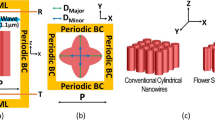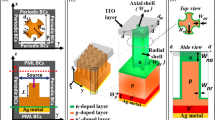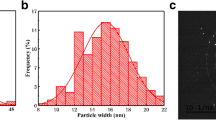Abstract
This work presents the influence of geometrical parameters on the absorption efficiency (Qabs), external quantum efficiencies (EQEs), and short-circuit current (JSC), and the efficiency of InGaP cylindrical core–shell nanowire (NW) solar cells with a circular cross-section was investigated. Numerical results obtained through finite-difference time-domain simulation showed that NW diameters ranging from 100 to 200 nm affected the absorption efficiency of the solar cells and leading to higher short-circuit current densities. The results enhance the efficiency of the solar cell that can be controlled by tuning the physical dimensions of InGaP NWs.





Similar content being viewed by others
References
L. Cao, S.L. White, S.J. Park, A.J. Schuller, M.B. Clemens, L.M. Brongersma, Engineering light absorption in semiconductor nanowire devices. Nat. Mater. 8, 643–647 (2009)
Y. Zhang, J. Wu, M. Aagesen, H. Liu, III–V nanowires and nanowire optoelectronic devices. J. Phys. D: Appl. Phys. 48, 463001 (2015)
M.A. Green, K. Emery, Y. Hishikawa, W. Warta, E.D. Dunlop, Solar cell efficiency tables (version 48). Prog. Photovolt. Res. Appl. 24, 905–913 (2016)
H. Zhang, J. Toudert, Optical management for efficiency enhancement in hybrid organic-inorganic lead halide perovskite solar cells. Sci. and Technol. of Adv. Mater. 19, 411–424 (2018)
E. Garnett, P. Yang, Light trapping in silicon nanowire solar cells. Nano Lett. 10, 1082–1087 (2010)
W. Yao, Y. Xin, Z. Xia, R. Xiaomin, Light absorption properties of a nanowire/quantum-dot hybrid, nanostructure array. Optics Communic. 420, 104–109 (2018)
R. Yu, Q. Lin, S.F. Leung, Z. Fan, Nanomaterials and nanostructures for efficient light absorption and photovoltaics. Nano Energ. 1, 57–72 (2012)
R.J. Jam, M. Heurlin, V. Jain, A. Kvennefors, M. Graczyk, I. Maximov, M.T. Borgström, H. Pettersson, L. Samuelson, III–V nanowire synthesis by use of electrodeposited gold particles. Nano Lett. 15, 134–138 (2014)
L. Hu, G. Chen, Analysis of optical absorption in silicon nanowire arrays for photovoltaic applications. Nano Lett. 7, 3249–3252 (2007)
E. Nikkei, M. Yoshimura, K. Tomioka, T. Fukui, GaAs/InGaP core–multishell nanowire-array-based solar cells. Japanese J. Appl. Phys. 52, 055002 (2013)
S. Adachi, Optical properties of In (1–x) GaxAsyP (1-y) alloys. Phys. Rev. B 39, 12612–12621 (1989)
A. Bensaada, J.T. Graham, J.L. Brebner, A. Chennouf, R.W. Cochrane, R. Leonelli, Band alignment in GaxIn1-xP/InP heterostructures. Appl. Phys. Lett. 64, 273–275 (1994)
N. Anttu, Geometrical optics, electrostatics, and nanophotonic resonances in absorbing nanowire arrays. Optics Lett. 38, 730–732 (2013)
U.P. Gomes, D. Ercolani, V. Zannier, F. Beltram, L. Sorba, Controlling the diameter distribution and density of InAs nanowires grown by Au-assisted methods. Semicond. Sci. Technol. 30, 115012 (2015)
H. Ye, P. Lu, Z. Yu, Y. Song, D. Wang, S. Wang, Critical thickness and radius for axial heterostructure nanowires using finite-element method. Nano Lett (2009). https://doi.org/10.1021/nl900055x
F.A. Abed, L.M. Ali, Investigation the absorption efficiency of GaAs/InAs nanowire solar cells. J. Luminescence 237, 118171 (2021)
L.M. Ali, F.A. Abed, Optic. Quant. Electron. 154, 52 (2020)
X. Yan, X. Zhang, X. Ren, X. Lv, J. Li, Q. Wang, S. Cai, Y. Huang, Formation mechanism and optical properties of InAs quantum dots on the surface of GaAs nanowires. Nano Lett. 12, 1851–1856 (2012). https://doi.org/10.1021/nl204204f
R.R. LaPierre, Numerical model of current-voltage characteristics and efficiency of GaAs nanowire solar cells. J Appl Phys 109, 034311 (2011). https://doi.org/10.1063/1.3544486
U. Wurfel, D. Neher, A. Spies, S. Albrecht, Impact of charge transport on current–voltage characteristics and power-conversion efficiency of organic solar cells. Nat. Communications 6, 6951 (2015)
H.J. Joyce, C.J. Docherty, Q. Gao, H.H. Tan, C. Jagadish, J. Lloyd-Hughes, L.M. Herz, M.B. Johnston, Electronic properties of GaAs, InAs and InP nanowires studied by terahertz spectroscopy. Nanotechnology 24, 214006 (2013)
X. Li, Y. Zhan, Enhanced external quantum efficiency in rectangular single nanowire solar cells. Appl. Phys. Lett. 102, 021101 (2013)
M. Levinshtein, S. Rumyantsev, M. Shur, Handbook Series on Semiconductor Parameters: Ternary and Quaternary III-V Compounds (World Scientific, Singapore, 1999)
L.M. Ali, F.A. Abed, Investigation the absorption efficiency of GaAs/InGaAs nanowire solar cells. Optic. Matera. 72, 650–653 (2017)
E.D. Palik, Handbook of Optical Constants of Solids (Academic, USA, 1985)
O.G. Keat, V.K. Oomman, M.K. Gopal, S. Karthik, G.A. Craig, Application of finite-difference time domain to dye-sensitized solar cells: The effect of nanotube-array negative electrode dimensions on light absorption. Sol. Energy Mater. Sol. Cell. 91, 250–257 (2007)
Z. Mauro, S. Igor, M. Jérôme, S. Enrico, F. Claudio, Advanced electro-optical simulation of nanowire-based solar cells. J. of Computa. Electron. 2, 572–584 (2013)
Author information
Authors and Affiliations
Corresponding author
Additional information
Publisher's Note
Springer Nature remains neutral with regard to jurisdictional claims in published maps and institutional affiliations.
Rights and permissions
About this article
Cite this article
Abed, F.A. Investigation the absorption efficiency of InGaP nanowire solar cells. J Opt 51, 161–164 (2022). https://doi.org/10.1007/s12596-021-00761-4
Received:
Accepted:
Published:
Issue Date:
DOI: https://doi.org/10.1007/s12596-021-00761-4




